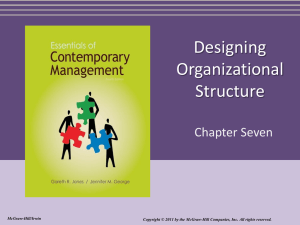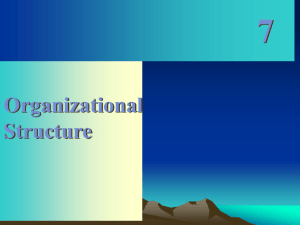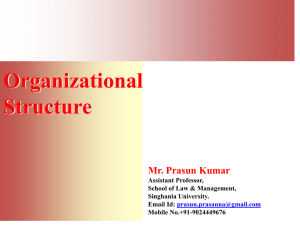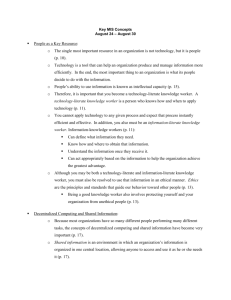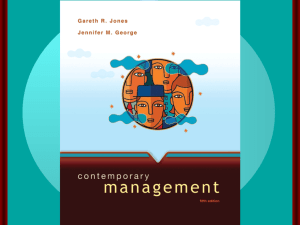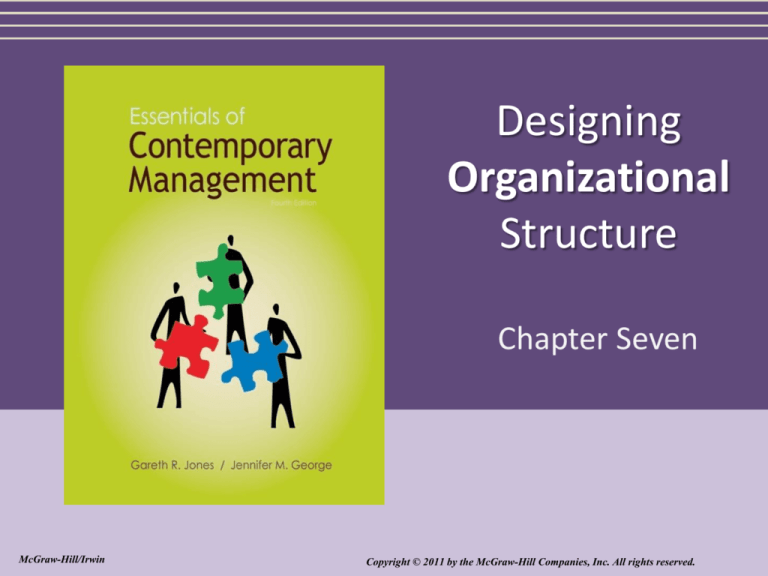
Designing
Organizational
Structure
Chapter Seven
McGraw-Hill/Irwin
Copyright © 2011 by the McGraw-Hill Companies, Inc. All rights reserved.
Learning Objectives
LO1 Identify the factors that influence managers’
choice of an organizational structure
LO2 Explain how managers group tasks into jobs
that are motivating and satisfying for
employees
LO3 Describe the types of organizational structures
managers can design, and explain why they
choose one structure over another
LO4 Explain why managers must coordinate jobs,
functions, and divisions using the hierarchy of
authority and integrating mechanisms.
7-2
Designing Organizational Structure
• Organizing
–The process by which managers establish the
structure of working relationships among
employees to achieve goals
7-3
Designing Organizational Structure
• Organizational Structure
–Formal system of task and reporting relationships
that coordinates and motivates organizational
members so that they work together to achieve
organizational goals
7-4
Designing Organizational Structure
• Organizational Design
– The process by which managers make specific
choices that result in a particular type of
organizational structure.
7-5
Factors Affecting Organizational
Structure
Figure 7.1
7-6
Factors Affecting Organizational Structure
• Environment (1)
– When the external environment is changing and
uncertainty exists, managers face greater
problems. In this situation, managers tend to use
flexible structures and entrepreneurial cultures,
to speed up decision making and communication.
– When the external environment is stable,
managers can establish more clearly defined
hierarchies and detailed rules.
7-7
Factors Affecting Organizational Structure
• Strategy (2)
– Different strategies require the use of different
organizational structures and cultures. Examples– A “differentiation” strategy used to increase
customer value might succeed best in a flexible
structure, or one that values innovation.
– A “low cost” strategy might be best in a structured
environment where managers maintain control.
7-8
Factors Affecting Organizational Structure
• Technology (3)
– Combination of skills, knowledge and machines
used to design and produce goods AND services.
– The more complicated the technology, the need for
a flexible structure and progressive culture.
– The more routine the technology (mass production)
the more a structured environment is needed so
that tasks are done efficiently.
7-9
Factors Affecting Organizational Structure
• Human Resources (4)
– The final factor affecting an organizations choice
of structure and culture.
– The more highly skilled the workforce, and the
great number of those who work in teams, the
more likely the organization will use a flexible
structure. Highly skilled employees desire greater
freedom and dislike close supervision.
7-10
Job Design
• Job Design
– The process managers use to divide tasks into
specific jobs (job descriptions)
• Job Simplification
– Reducing the number of tasks a worker performs
• When is it necessary to do this?
–Production Lines (Subway, McDonalds, autos)
• What is an undesired result of this process?
– Boredom
7-11
Job Design
• Job Enlargement
– The process of increasing the number of different
tasks in a job by changing the division of labor
• Job Enrichment
– The process of increasing the degree of
responsibility a worker has over a job
7-12
Question?
What term below refers to increasing the
degree of responsibility a worker has over
his or her job?
A.
B.
C.
D.
Job Design
Job Simplification
Job Enlargement
Job Enrichment
7-13
The Job Characteristics Model
Figure 7.2
7-14
Job Characteristics Model
Job Characteristic
Skill variety
Employee uses a wide range of skills.
Task identity
Worker is involved in all tasks of the job
from beginning to end of the production
process
Task significance
Worker feels the task is meaningful to
organization.
Autonomy
Employee has freedom to schedule tasks
and carry them out.
Feedback
Worker gets direct information about how
well the job is done.
7-15
1-Functional Structure
• Functional Structure
– An organizational
structure composed of
all the departments
that an organization
requires to produce its
goods or services
7-16
Grouping Jobs into Functions
• Advantages
• Disadvantages
– Encourages learning
– Difficult for
from others doing
departments to
similar jobs
communicate with
others
– Easy for managers to
monitor and evaluate
– Preoccupation with
workers
own department and
losing sight of
– More control
organizational goals
– Hard to grow
7-17
2-Divisional Structures
• Divisional Structure
– An organizational structure composed of separate
business units within which are the functions that
work together to produce a specific product for a
specific customer
– 3 Types: Product, Geographic and Market
7-18
a-Product Structure
• Product Structure
– Each product line or
business is handled
by a self-contained
division
• For Example
– Pharmaceuticals
7-19
a-Product Structure-con’t
Advantages
•
•
•
•
Functional managers specialize in 1 product area
Division managers become experts in their area
No need for direct supervision by corporate mgrs
By using Divisional Managers, the use of resources
improves
7-20
b-Geographic Structure
• Geographic Structure
– Each region of a country or area of the world is
served by a self-contained division (FedEx)
• Global Geographic Structure
– Managers locate different divisions in each of the
world regions where the organization operates
– Generally, occurs when managers are
pursuing a multi-domestic strategy (Nokia)
7-21
c-Market Structure
• Market Structure
– Each kind of customer is served by a selfcontained division
– Also called “customer structure”
– Dell serves: Corporations, small businesses, home
computer users and government/state agencies
7-22
3-Matrix Design Structure
• Matrix Structure
– An organizational
structure that
simultaneously
groups people and
resources by function
and product
Works well when
employees are grouped
in teams to develop
new products (R and D)
7-23
4-Product Team Design Structure
• Product Team Structure
– Members are permanently assigned to a crossfunctional team and report only to the product
team manager or to one of his subordinates
• Cross-functional team
– Group of managers brought together from
different departments to perform organizational
tasks (automotive industry)
7-24
5-Hybrid Structures
• Hybrid Structure
– The structure of a large organization that has
many divisions and simultaneously uses many
different organizational structures
7-25
Macy’s Hybrid Structure
Figure 7.7
7-26
Coordinating Functions and Divisions
• Authority
– The power to hold people accountable for their
actions and to make decisions concerning the use
of organizational resources
• Hierarchy of Authority
– An organization’s chain of command, specifying
the relative authority of each manager
7-27
Allocating Authority
• Span of Control
– The number of subordinates that report directly to a
manager
• Line Manager
– Someone in the direct line or chain of command who
has formal authority over people and resources
• Staff Manager
– Someone responsible for managing a specialist
function, such as finance or marketing
7-28
Tall and Flat Organizations
Figure 7.9
7-29
Tall and Flat Organizations
• Decentralizing authority
– Giving lower-level managers and non-managerial
employees the right to make important decisions
about how to use organizational resources.
– When organizations are too “tall”
• The numbers of managers increase
• Managers are costly for the organization
• In an economic downturn, middle managers
are laid off
7-30
Types of Integrating Mechanisms
• Integrating Mechanisms
– Organizing tools that managers can use to
increase communication and coordination among
functions and divisions. Managers can use:
• Direct Contact
• Task Forces
• Cross-functional Teams
7-31
Strategic Alliances
• Strategic Alliance
– An agreement in which managers pool or share
firm’s resources and know-how with a foreign
company. The two firms share in the rewards and
risks of starting a new venture.
• Outsource
– To use outside suppliers and manufacturers to
produce goods and services
7-32
Strategic Alliances
• Network Structure
–A series of strategic alliances that an organization
creates with suppliers, manufacturers, and
distributors to produce and market a product
–Network structures allow firms to bring resources
together in a boundary-less organization
7-33
Strategic Alliances
• Boundary-less Organization
– An organization whose members are linked by
computers, faxes, computer-aided design systems,
and video-conferencing and who, rarely, if ever,
see one another face-to-face
7-34

